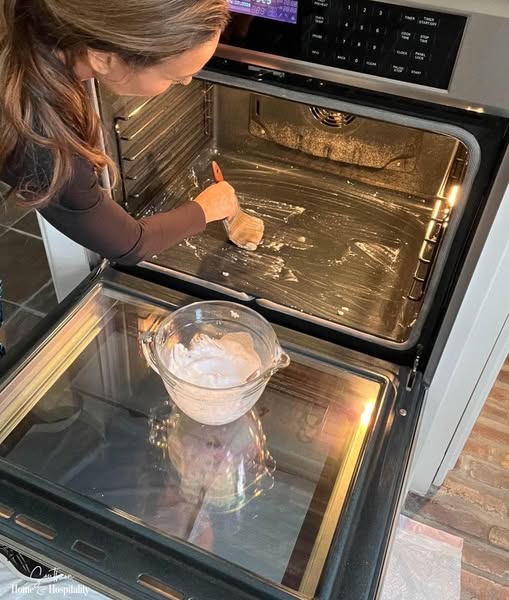Step-by-Step Cleaning Process
1. Preparation (15 minutes)
- Remove oven racks and any loose debris
- Place racks in the sink or bathtub for separate cleaning
- Create your cleaning paste by mixing:
- ½ cup baking soda
- 3-4 tablespoons of water (adjust for desired consistency)
- The paste should be spreadable but not too runny
2. Application (10 minutes)
- Put on your rubber gloves
- Using your hands or a clean cloth, spread the paste throughout the oven’s interior
- Pay special attention to:
- Heavily soiled areas
- Baked-on food spots
- Grease accumulation
- Avoid:
- Heating elements
- Oven door seal
- Gas vents
3. Waiting Period (12-24 hours)
- Let the paste work its magic
- For light cleaning: 30 minutes minimum
- For tough stains: overnight
- The paste will turn brownish as it absorbs grease
4. The Vinegar Treatment (5 minutes)
- Fill your spray bottle with white vinegar
- Spray generously over the dried baking soda paste
- Watch the satisfying fizzing reaction
- This reaction helps lift stubborn grime
5. The Clean-Up (20-30 minutes)
- Using a damp cloth, wipe away all paste residue
- For stubborn spots:
- Add a drop of dish soap to your cloth
- Use gentle circular motions
- Rinse cloth frequently
- Wipe multiple times with clean water
6. Final Touches (10 minutes)
- Dry the interior with a clean cloth
- Replace the oven racks
- Optional: Leave a bowl of baking soda overnight to absorb odors
Pro Tips for Best Results
- Timing Matters: Clean your oven when you won’t need it for at least 24 hours
- Regular Maintenance: Clean spills immediately to prevent baked-on messes
- Ventilation: Keep your kitchen well-ventilated during cleaning
- Spot Testing: Test the paste on a small area first
- Rack Cleaning: Soak racks in hot soapy water while the oven paste works
Maintaining Your Clean Oven
To keep your oven cleaner longer:
- Place a baking sheet under dishes that might bubble over
- Clean spills promptly
- Wipe down the oven weekly with a damp cloth
- Use the self-cleaning function (if available) every few months
Environmental Impact
By choosing this natural cleaning method, you’re:
- Reducing chemical waste
- Minimizing plastic packaging waste
- Protecting water systems
- Supporting sustainable cleaning practices
Frequently Asked Questions
Q: How often should I deep clean my oven?
A: Every 3-4 months for regular use, more frequently for heavy use.
Q: Is this method safe for all oven types?
A: Yes, this method is safe for traditional, convection, and self-cleaning ovens.
Q: Can I use this method on a warm oven?
A: No, always clean your oven when it’s completely cool.
Conclusion
Natural oven cleaning might take a bit more time than chemical cleaners, but the results are worth it. You’ll have a sparkling clean oven without exposing your home to harsh chemicals or fumes. Plus, you’ll save money while helping the environment!
Remember to always test any cleaning method in a small area first and ensure proper ventilation during cleaning.
